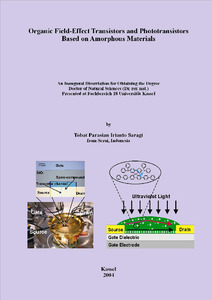| dc.date.accessioned | 2006-04-27T10:41:08Z | |
| dc.date.available | 2006-04-27T10:41:08Z | |
| dc.date.issued | 2005-02-28 | |
| dc.identifier.uri | urn:nbn:de:hebis:34-2091 | |
| dc.identifier.uri | http://hdl.handle.net/123456789/2091 | |
| dc.format.extent | 5407361 bytes | |
| dc.format.mimetype | application/pdf | |
| dc.language.iso | eng | |
| dc.rights | Urheberrechtlich geschützt | |
| dc.rights.uri | https://rightsstatements.org/page/InC/1.0/ | |
| dc.subject | Transistoren | eng |
| dc.subject | Phototransistoren | eng |
| dc.subject | Amorphe Materialien | eng |
| dc.subject | Spiroverbindungen | eng |
| dc.subject | Transistor | eng |
| dc.subject | Phototransistor | eng |
| dc.subject | Amorphous materials | eng |
| dc.subject | Spiro-compounds | eng |
| dc.subject.ddc | 540 | |
| dc.title | Organic field-effect transistors and phototransistors based on amorphous materials | eng |
| dc.type | Dissertation | |
| dcterms.abstract | A comparison between the charge transport properties in low molecular amorphous thin films of spiro-linked compound and their corresponding parent compound has been demonstrated. The field-effect transistor method is used for extracting physical parameters such as field-effect mobility of charge carriers, ON/OFF ratios, and stability. In addition, phototransistors have been fabricated and demonstrated for the first time by using organic materials. In this case, asymmetrically spiro-linked compounds are used as active materials. The active materials used in this study can be divided into three classes, namely Spiro-linked compounds (symmetrically spiro-linked compounds), the corresponding parent-compounds, and photosensitive spiro-linked compounds (asymmetrically spiro-linked com-pounds). Some of symmetrically spiro-linked compounds used in this study were 2,2',7,7'-Tetrakis-(di-phenylamino)-9,9'-spirobifluorene (Spiro-TAD),2,2',7,7'-Tetrakis-(N,N'-di-p-methylphenylamino)-9,9'-spirobifluorene (Spiro-TTB), 2,2',7,7'-Tetra-(m-tolyl-phenylamino)-9,9'-spirobifluorene (Spiro-TPD), and 2,2Ž,7,7Ž-Tetra-(N-phenyl-1-naphtylamine)-9,9Ž-spirobifluorene (Spiro alpha-NPB). Related parent compounds of the symmetrically spiro-linked compound used in this study were N,N,N',N'-Tetraphenylbenzidine (TAD), N,N,N',N'-Tetrakis(4-methylphenyl)benzidine (TTB), N,N'-Bis(3-methylphenyl)-(1,1'-biphenyl)-4,4'-diamine (TPD), and N,N'-Diphenyl-N,N'-bis(1-naphthyl)-1,1'-biphenyl-4,4'-diamine (alpha-NPB). The photosensitive asymmetrically spiro-linked compounds used in this study were 2,7-bis-(N,N'-diphenylamino)-2',7'-bis(biphenyl-4-yl)-9,9'-spirobifluorene (Spiro-DPSP), and 2,7-bis-(N,N'-diphenylamino)-2',7'-bis(spirobifluorene-2-yl)-9,9'-spirobifluorene (Spiro-DPSP^2). It was found that the field-effect mobilities of charge carriers in thin films of symmetrically spiro-linked compounds and their corresponding parent compounds are in the same order of magnitude (~10^-5 cm^2/Vs). However, the thin films of the parent compounds were easily crystallized after the samples have been exposed in ambient atmosphere and at room temperature for three days. In contrast, the thin films and the transistor characteristics of symmetrically spiro-linked compound did not change significantly after the samples have been stored in ambient atmosphere and at room temperature for several months. Furthermore, temperature dependence of the mobility was analyzed in two models, namely the Arrhenius model and the Gaussian Disorder model. The Arrhenius model tends to give a high value of the prefactor mobility. However, it is difficult to distinguish whether the temperature behaviors of the material under consideration follows the Arrhenius model or the Gaussian Disorder model due to the narrow accessible range of the temperatures. For the first time, phototransistors have been fabricated and demonstrated by using organic materials. In this case, asymmetrically spiro-linked compounds are used as active materials. Intramolecular charge transfer between a bis(diphenylamino)biphenyl unit and a sexiphenyl unit leads to an increase in charge carrier density, providing the amplification effect. The operational responsivity of better than 1 A/W can be obtained for ultraviolet light at 370 nm, making the device interesting for sensor applications. This result offers a new potential application of organic thin film phototransistors as low-light level and low-cost visible blind ultraviolet photodetectors. | eng |
| dcterms.abstract | In dieser Arbeit wurden die elektrischen Eigenschaften von amorphen Materialien bzw. Spiroverbindungen mit ihren Stammverbindungen verglichen. Die Methode beruht auf der Herstellung von organischen Feldeffekttransistoren, bei denen die organisch aktive Schicht auf ein Substrat mit vorpräparierten Elektroden aufgebracht wird. Mit dieser Methode wird die Beweglichkeit der Ladungsträger bestimmt. Außerdem wurde zum ersten Mal ein Phototransistor auf der Basis organischer Materialien bzw. unsymmetrischer Spiroverbindungen demonstriert. Als organische Materialien wurden die molekularen Gläser 2,2',7,7'-Tetrakis-(diphenylamino)-9,9'-spirobifluoren (Spiro-TAD), 2,2',7,7'-Tetra-(m-tolyl-phenylamino)-9,9'-spirobifluoren (Spiro-TPD), 2,2',7,7'-Tetrakis-(N,N'-di-p-methylphenylamino)-9,9'-spirobifluoren (Spiro-TTB), 2,2',7,7'-Tetra-(N-phenyl-1-naphthylamino)-9,9Ž-spirobifluoren (Spiro alpha-NPB), N,N,N',N'-Tetraphenylbenzidin (TAD), N,N'-Bis(3-methylphenyl)-(1,1'-biphenyl)-4,4'-diamin (TPD), N,N,N',N'-tetrakis(4-methyl-phenyl) benzidin (TTB) und N,N'-diphenyl-N,N'-bis(1-naphthyl)-1,1'-biphenyl-4,4'-diamin (alpha-NPB) verwendet. Die photoaktiven Materialen waren 2,7-Bis-(N,N'-diphenylamino)-2',7'-bis(biphenyl-4-yl)-9,9'-spirobifluoren (Spiro-DPSP) und 2,7-Nis-(N,N'-diphenylamino)-2',7'-bis(spirobifluoren-2-yl)-9,9'-spirobifluoren (Spiro-DPSP^2). Die Ladungsträgerbeweglichkeiten in beiden Materialklassen sind sehr ähnlich (~10^-5 cm^2/Vs). Die Stammverbindungen neigen zu Kristallisation, wie sich durch Charakterisierung der Oberflächenmorphologie nachweisen läßt. Im Gegensatz dazu kristallisieren die Spiroverbindungen deutlich langsamer. Die Temperaturabhängigkeit der Löcherbeweglichkeiten von allen Materialien wurde auch untersucht. Alle Materialien folgen dem Modell eines thermisch aktivierten Ladungsträgertransportes eher als dem Unordnungsmodell, wobei die Aktivierungsenergien in den verschiedenen Materialien unterschiedlich sind. Das Spirokonzept bewirkt also eine hohe morphologische Stabilität im Glaszustand bei Erhaltung der Ladungsträgerbeweglichkeit. Im letzten Teil wurde ein Phototransistor auf der Basis unsymmetrischer Spiroverbindungen demonstriert. Dieser Phototransistor besteht aus einem Substrat, einem Gatekontakt, einem Dielektrikum, zwei leitfähigen Kontakten und einer unsymmetrischen Spiroverbindung, die aus zwei unterschiedlichen, in einem Material kombinierten, Chromophoren besteht. UV-Licht wirkt dabei als zusätzlicher Steuerparameter. Durch photoinduzierten Ladungstransfer wird im Kanal zwischen Source und Drain eine höhere Ladungsträgerkonzentration erzeugt und damit das Kennlinienfeld beeinflußt. Mit diesem Resultat ist die Herstellung eines Photodetektors im UV-Bereich möglich. | eng |
| dcterms.accessRights | open access | |
| dcterms.creator | Saragi, Tobat Parasian Irianto | |
| dc.contributor.corporatename | Kassel, Universität, FB 18, Naturwissenschaften, Institut für Chemie | |
| dc.contributor.referee | Salbeck, Josef (Prof. Dr.) | |
| dc.subject.swd | Organischer Halbleiter | ger |
| dc.subject.swd | Feldeffekttransistor | ger |
| dc.subject.swd | Phototransistor | ger |
| dc.subject.swd | Spiroverbindungen | ger |
| dc.date.examination | 2004-12-10 | |

